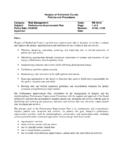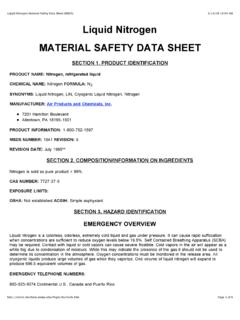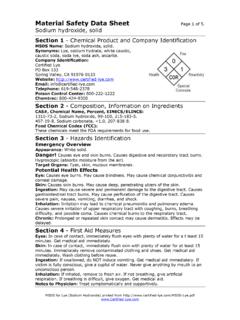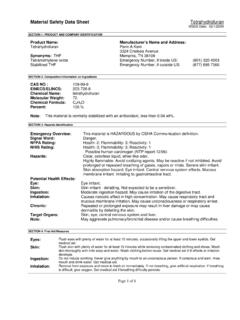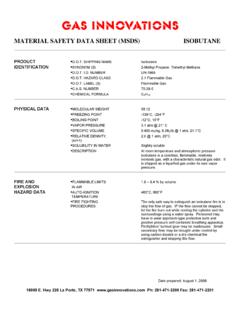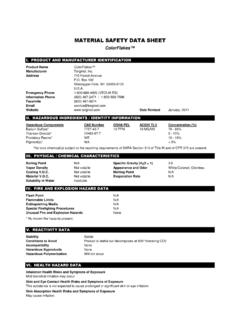Transcription of Material Safety Data Sheets (MSDS) Spill Clean …
1 Material Safety data Sheets ( msds ), Spill Clean -Up Definitions Flammable: A substance having a flash point below 100 degrees Fahrenheit - easily ignited and quick burning. Toxic: A substance which has the capacity, through chemical reaction or mixture, to produce injury or harm to the body by entry through absorption, ingestion, inhalation, or injection. Caustic: A substance with the capability of burning, destroying or eating away organic tissue by chemical reaction - Corrosive. Material Safety data Sheets ( msds ) Hospice of Rutherford County contracts with msds Online to provide msds on all chemicals.
2 Hospice keeps a log and manual with msds on all chemicals used. The log is located in the Business Department and Kathy Pierce is the msds Coordinator. You may also contact msds Online at 1-888-362-2007 or log on at You need a user name and a user password. They will provide a msds sheet via fax to you if urgently requested. Material Safety data Sheets ( msds ) The msds is used by chemical manufacturers and vendors to convey hazard information to users. A msds should be obtained when a chemical is purchased. A chemical inventory list, and msds , for each chemical are required to be maintained.
3 Reading the msds Information on the msds is organized in 16 sections as follows: 1 Product Name and Manufacture. Includes the commercial name of chemical, any common names and contact information for the manufacturer. 2 Chemical Composition. List all ingredients, including all carcinogens. 3 Hazard Identification. States potential hazards of chemical if inhaled, ingested or comes in contact with skin or eyes. Details effects of long-term exposure. 4 First Aid Measures. Explain necessary first aid for the types of exposures detailed in previous category.
4 Continued on next Reading the msds 16 Sections Continued 5 Fire Fighting Measures. Includes the chemical s flammable properties and explains the best methods for putting out flames created by the chemical. 6 Accidental Release Measures. Explains Safety precautions when a chemical may be spilled or released into the air. Describes the best Clean -up procedures and recommends necessary personal protective equipment for cleaning up spills. 7 Handling and Storage. Advises how to handle chemicals and recommends best conditions for storage.
5 Continued on next Reading the msds 16 Sections Continued 8 Exposure Controls/Personal Protection. Can list the Personal Exposure Limit (PEL) and the Threshold Limit Valve (TLV) for airborne substances. Lists necessary equipment a facility needs and necessary personal protective equipment. 9 Physical and Chemical Properties. Lists all properties and characteristics of the chemical. 10 Stability and Reactivity. Describes the stability of the chemical, what conditions to avoid, and its incompatibility with other chemicals.
6 Specific storage instructions may be included here. 11 Toxicological Information. Describes the symptoms and treatments of chemical poisoning and the effects the chemical can have on human health. States the adverse effects that result from ingestion, inhalation and skin contact or absorption. Continued on next Reading the msds 16 Sections Continued 12 Ecological Information. Describes the chemical s effect on plants and animals. Explains what happens to the chemical after it has been released into the environment.
7 13 Disposal Considerations. Suggests the best method of disposing the chemical. 14 Transportation Information. Details the shipping and transportation of hazardous chemicals. 15 Regulatory Information. Lists government regulations of the chemical and if it has been classified as hazardous. 16 Other Information. Features further information not already included. OSHA Requirements OSHA requires that all msds Sheets be written in English and include the following: The common name of a hazardous single substance chemical. The chemicals and common names of the ingredients that contribute to a chemical mixture tested for hazards as a whole.
8 If a hazardous chemical mixture has not been tested as a whole, then the chemical and common names of all ingredients are determined to be a health hazards. The chemical and common names of all ingredients found to pose a physical hazard when in a mixture. Physical and chemical characteristics, such as a vapor pressure and flash point, of a hazardous chemical. OSHA Requirements (cont.) Employee exposure limit. The potential health hazards of the chemical, including symptoms of exposure, and any medical conditions known as resulting from exposure to a chemical.
9 If the chemical has been found to be a potential carcinogen. General precautions for safely handling chemicals. General control measuring for working with chemicals. Emergency and first-aid procedures. The date of when the msds was prepared or last time it was updated. Name, address and telephone number of the chemical manufacturer. Spill Clean -Up Minor spills should be cleaned-up at the time of the Spill . Major spills may require special treatment, equipment or emergency assistance. Personal Protective Equipment (PPE), such as rubber gloves and goggles, shall be available to staff when dealing with hazardous materials.
10 An approved Spill kit should be readily available to all staff. When necessary, report the chemical Spill and call 911 if there are any injuries. When necessary, restrict access to the Spill area. If the spilled chemical is flammable, make sure that there is no smoking in the area and turn off machinery and other power equipment.

